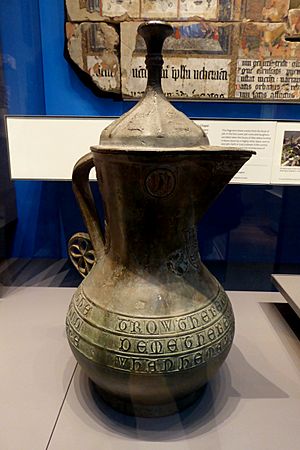Asante Ewer facts for kids
The Asante Ewer or Asante Jug is a special bronze jug with a lid. It was made a long time ago, around the 1390s. This jug is very important because it's one of the few English bronze jugs from the 1300s that still exists. It helps us learn about how metal was worked in England back then. The jug was taken from Kumasi in Asante (which is now Ghana) during a war called the Fourth Anglo-Ashanti War in 1895. Since 1896, it has been kept at the British Museum in London.
Contents
What Does the Asante Jug Look Like?
The front of the Asante Jug has a cool design. It shows the Royal Arms of England from the late 1300s. This design has a crown on top and two lion figures holding it up.
Messages on the Jug
Below the royal arms, there are three lines of writing. The letters are in an old style called Lombardic script. They read:
- "+ HE THAT WYL NOT SPARE WHEN HE MAY HE SHALL NOT / SPEND WHEN HE WOULD DEME THE BEST IN EVERY / DOWT TIL THE TROWTHE BE TRYID OWTE"
This old English message means two things:
- "Someone who doesn't save when they can, won't have money to spend when they want to."
- "Think the best in every unsure situation until the truth is found out."
Other Decorations
The neck of the jug has six round designs, three on each side. Each one shows a falcon spreading its wings. There are also falcons near the spout and on either side of the handle. On the very edge of the jug's opening, there are three lions facing left. There is also a stag (a male deer) in a circle facing right.
The lid of the jug has seven sides and is the original one. Each section of the lid has a lion above a stag lying down. The handle of the jug ends with a fancy, scrolled shape.
Size and Weight
Without its lid, the jug is about 43.3 centimeters (about 17 inches) tall. The lid itself is about 19.6 centimeters (about 7.7 inches) tall. When the lid is on, the whole jug is about 62.3 centimeters (about 24.5 inches) tall. It weighs about 18.6 kilograms (about 41 pounds). It can hold about 15.8 liters (about 4.2 gallons) of liquid. Because it's so heavy when full, it would have been hard to use for pouring.
Other Jugs Like It
The Asante Jug is very rare. Only two other similar jugs are known in the United Kingdom. All three jugs look alike and have similar writing in English. They were all made from a type of bronze that includes lead. They were cast (shaped using a mold) in a similar way. They also have similar royal symbols as decorations. The Asante Jug is the biggest of the three, and it's the only one that still has its original lid.
The Other Two Jugs
One of the other jugs is called the Wenlok jug. It's the smallest and is now in Luton. The third jug is the Robinson jug. It was found in a farmhouse in Norfolk in 1879 and is now at the Victoria and Albert Museum. The Wenlok and Robinson jugs both had places for a hinged lid, but their lids are now missing.
Where They Were Made
All three of these special jugs were made in England. The royal symbols on the Asante Jug suggest it might be linked to King Edward III or King Richard II. The stag symbols on the lid point more to Richard II, who used a white stag as his symbol in the 1390s.
How it Got to Africa
The Asante Jug was found in the Manhyia Palace in Kumasi in 1895. No one knows for sure when or how it arrived in West Africa. Some people think it was brought from Europe to Africa a long time ago as a valuable gift for an African ruler. There is even a photograph from 1887 that shows the jug under a sacred tree at the royal palace.
Another simple English jug from the 1300s is kept at the Leeds City Museum.
History of the Asante Jug
The British Museum bought the Asante Jug in 1896. They bought it from Major General Charles St Leger Barter. He was a soldier who served in the Fourth Anglo-Ashanti War. This war took place from December 1895 to February 1896. During this war, the British forces reached Kumasi and removed the local ruler, the Asantehene Prempeh I.


